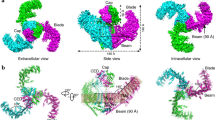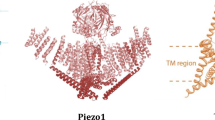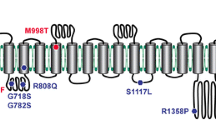Abstract
Rapid sensation of mechanical stimuli is often mediated by mechanosensitve ion channels. Their opening results from conformational changes induced by mechanical forces. It leads to membrane permeation of selected ions and thereby to electrical signaling. Newly identified mechanosensitive ion channels are emerging at an astonishing rate, including some that are traditionally assigned for completely different functions. In this review, we first provide a brief overview of ion channels that are known to play a role in mechanosensation. Next, we focus on three representative ones, including the transient receptor potential channel V4 (TRPV4), Kv1.1 voltage-gated potassium (Kv) channel, and Piezo channels. Their structures, biophysical properties, expression and targeting patterns, and physiological functions are highlighted. The potential role of their mechanosensation in related diseases is further discussed. In sum, mechanosensation appears to be achieved in a variety of ways by different proteins and plays a fundamental role in the function of various organs under normal and abnormal conditions.


Similar content being viewed by others
References
Eyckmans J et al (2011) A hitchhiker's guide to mechanobiology. Dev Cell 21(1):35–47
Tyler WJ (2012) The mechanobiology of brain function. Nat Rev Neurosci 13(12):867–878
Gillespie PG, Walker RG (2001) Molecular basis of mechanosensory transduction. Nature 413(6852):194–202
Vogel V, Sheetz M (2006) Local force and geometry sensing regulate cell functions. Nat Rev Mol Cell Biol 7(4):265–275
Sachs F (2010) Stretch-activated ion channels: what are they? Physiology (Bethesda) 25(1):50–56
Haswell ES, Phillips R, Rees DC (2011) Mechanosensitive channels: what can they do and how do they do it? Structure 19(10):1356–1369
Roudaut Y et al (2012) Touch sense: functional organization and molecular determinants of mechanosensitive receptors. Channels (Austin) 6(4):234–245
Hao J et al (2013) Kv1.1 channels act as mechanical brake in the senses of touch and pain. Neuron 77(5):899–914
Corey DP, Hudspeth AJ (1979) Response latency of vertebrate hair cells. Biophys Jo 26(3):499–506
Coste B et al (2012) Piezo proteins are pore-forming subunits of mechanically activated channels. Nature 483(7388):176–181
McCarter GC, Reichling DB, Levine JD (1999) Mechanical transduction by rat dorsal root ganglion neurons in vitro. Neurosci Lett 273(3):179–182
Davis MJ, Donovitz JA, Hood JD (1992) Stretch-activated single-channel and whole cell currents in vascular smooth muscle cells. Am J Physiol 262(4 Pt 1):C1083–C1088
Praetorius HA, Spring KR (2001) Bending the MDCK cell primary cilium increases intracellular calcium. J Membr Biol 184(1):71–79
Maroto R et al (2005) TRPC1 forms the stretch-activated cation channel in vertebrate cells. Nat Cell Biol 7(2):179–185
Hao J, Delmas P (2010) Multiple desensitization mechanisms of mechanotransducer channels shape firing of mechanosensory neurons. J Neurosci 30(40):13384–13395
Nilius B, Honore E (2012) Sensing pressure with ion channels. Trends Neurosci 35(8):477–486
Christensen AP, Corey DP (2007) TRP channels in mechanosensation: direct or indirect activation? Nat Rev Neurosci 8(7):510–521
Arnadottir J, Chalfie M (2010) Eukaryotic mechanosensitive channels. Annu Rev Biophys 39:111–137
Sukharev SI et al (1994) A large-conductance mechanosensitive channel in E. coli encoded by mscL alone. Nature 368(6468):265–268
Cosens DJ, Manning A (1969) Abnormal electroretinogram from a Drosophila mutant. Nature 224(5216):285–287
Montell C, Rubin GM (1989) Molecular characterization of the Drosophila trp locus: a putative integral membrane protein required for phototransduction. Neuron 2(4):1313–1323
Venkatachalam K, Montell C (2007) TRP channels. Annu Rev Biochem 76:387–417
Liedtke W, Kim C (2005) Functionality of the TRPV subfamily of TRP ion channels: add mechano-TRP and osmo-TRP to the lexicon! Cell Mol Life Sci 62(24):2985–3001
Palmer CP et al (2001) A TRP homolog in Saccharomyces cerevisiae forms an intracellular Ca(2+)-permeable channel in the yeast vacuolar membrane. Proc Natl Acad Sci U S A 98(14):7801–7805
Guler AD et al (2002) Heat-evoked activation of the ion channel, TRPV4. J Neurosci 22(15):6408–6414
Xiao R, Xu XZ (2010) Mechanosensitive channels: in touch with Piezo. Curr Biol 20(21):R936–R938
Liedtke W, Friedman JM (2003) Abnormal osmotic regulation in trpv4−/− mice. Proc Natl Acad Sci U S A 100(23):13698–13703
Lamande SR et al (2011) Mutations in TRPV4 cause an inherited arthropathy of hands and feet. Nat Genet 43(11):1142–1146
Lei L et al (2013) A TRPV4 channel C-terminal folding recognition domain critical for trafficking and function. J Biol Chem 288(15):10427–10439
Watanabe H et al (2003) Anandamide and arachidonic acid use epoxyeicosatrienoic acids to activate TRPV4 channels. Nature 424(6947):434–438
Sidhaye VK et al (2006) Transient receptor potential vanilloid 4 regulates aquaporin-5 abundance under hypotonic conditions. Proc Natl Acad Sci U S A 103(12):4747–4752
Vriens J et al (2004) Cell swelling, heat, and chemical agonists use distinct pathways for the activation of the cation channel TRPV4. Proc Natl Acad Sci U S A 101(1):396–401
Liedtke W et al (2000) Vanilloid receptor-related osmotically activated channel (VR-OAC), a candidate vertebrate osmoreceptor. Cell 103(3):525–535
Strotmann R et al (2000) OTRPC4, a nonselective cation channel that confers sensitivity to extracellular osmolarity. Nat Cell Biol 2(10):695–702
D'Hoedt D et al (2008) Stimulus-specific modulation of the cation channel TRPV4 by PACSIN 3. J Biol Chem 283(10):6272–6280
Cuajungco MP et al (2006) PACSINs bind to the TRPV4 cation channel. PACSIN 3 modulates the subcellular localization of TRPV4. J Biol Chem 281(27):18753–18762
Suzuki M et al (2003) Impaired pressure sensation in mice lacking TRPV4. J Biol Chem 278(25):22664–22668
Fernandes J et al (2008) IP3 sensitizes TRPV4 channel to the mechano- and osmotransducing messenger 5′–6′-epoxyeicosatrienoic acid. J Cell Biol 181(1):143–155
Garcia-Elias A et al (2008) IP3 receptor binds to and sensitizes TRPV4 channel to osmotic stimuli via a calmodulin-binding site. J Biol Chem 283(46):31284–31288
Alessandri-Haber N et al (2008) Interaction of transient receptor potential vanilloid 4, integrin, and SRC tyrosine kinase in mechanical hyperalgesia. J Neurosci 28(5):1046–1057
Shibasaki K et al (2007) Effects of body temperature on neural activity in the hippocampus: regulation of resting membrane potentials by transient receptor potential vanilloid 4. J Neurosci 27(7):1566–1575
Bai JZ, Lipski J (2010) Differential expression of TRPM2 and TRPV4 channels and their potential role in oxidative stress-induced cell death in organotypic hippocampal culture. Neurotoxicology 31(2):204–214
Deng HX et al (2010) Scapuloperoneal spinal muscular atrophy and CMT2C are allelic disorders caused by alterations in TRPV4. Nat Genet 42(2):165–169
Landoure G et al (2010) Mutations in TRPV4 cause Charcot–Marie–Tooth disease type 2C. Nat Genet 42(2):170–174
Zimon M et al (2010) Dominant mutations in the cation channel gene transient receptor potential vanilloid 4 cause an unusual spectrum of neuropathies. Brain 133(Pt 6):1798–1809
Auer-Grumbach M et al (2010) Alterations in the ankyrin domain of TRPV4 cause congenital distal SMA, scapuloperoneal SMA and HMSN2C. Nat Genet 42(2):160–164
Zhang DX et al (2009) Transient receptor potential vanilloid type 4-deficient mice exhibit impaired endothelium-dependent relaxation induced by acetylcholine in vitro and in vivo. Hypertension 53(3):532–538
O'Conor CJ et al (2013) Increased susceptibility of Trpv4-deficient mice to obesity and obesity-induced osteoarthritis with very high-fat diet. Ann Rheum Dis 72(2):300–304
Gu C, Barry J (2011) Function and mechanism of axonal targeting of voltage-sensitive potassium channels. Prog Neurobiol 94(2):115–132
Gu C et al (2006) The microtubule plus-end tracking protein EB1 is required for Kv1 voltage-gated K + channel axonal targeting. Neuron 52(5):803–816
Xu M et al (2007) The axon-dendrite targeting of Kv3 (Shaw) channels is determined by a targeting motif that associates with the T1 domain and ankyrin G. J Neurosci 27(51):14158–14170
Barry J et al (2013) Activation of conventional kinesin motors in clusters by Shaw voltage-gated K+ channels. J Cell Sci 126(Pt 9):2027–2041
Gu C, Gu Y (2010) Clustering and activity tuning of Kv1 channels in myelinated hippocampal axons. J Biol Chem 286(29):25835–25847
Tabarean IV, Morris CE (2002) Membrane stretch accelerates activation and slow inactivation in Shaker channels with S3–S4 linker deletions. Biophys J 82(6):2982–2994
Laitko U, Morris CE (2004) Membrane tension accelerates rate-limiting voltage-dependent activation and slow inactivation steps in a Shaker channel. J Gen Physiol 123(2):135–154
Robbins CA, Tempel BL (2012) Kv1.1 and Kv1.2: similar channels, different seizure models. Epilepsia 53(Suppl 1):134–141
Simeone TA et al (2013) Loss of the Kv1.1 potassium channel promotes pathologic sharp waves and high frequency oscillations in in vitro hippocampal slices. Neurobiol Dis 54:68–81
Zenker J et al (2012) Altered distribution of juxtaparanodal Kv1.2 subunits mediates peripheral nerve hyperexcitability in type 2 diabetes mellitus. J Neurosci 32(22):7493–7498
Van der Wijst J et al (2010) Functional analysis of the Kv1.1 N255D mutation associated with autosomal dominant hypomagnesemia. J Biol Chem 285(1):171–178
Glaudemans B et al (2009) A missense mutation in the Kv1.1 voltage-gated potassium channel-encoding gene KCNA1 is linked to human autosomal dominant hypomagnesemia. J Clin Invest 119(4):936–942
Coste B et al (2010) Piezo1 and Piezo2 are essential components of distinct mechanically activated cation channels. Science 330(6000):55–60
Gottlieb PA, Sachs F (2012) Piezo1: properties of a cation selective mechanical channel. Channels (Austin) 6(4):214–219
Zarychanski R et al (2012) Mutations in the mechanotransduction protein PIEZO1 are associated with hereditary xerocytosis. Blood 120(9):1908–1915
Andolfo I et al (2013) Multiple clinical forms of dehydrated hereditary stomatocytosis arise from mutations in PIEZO1. Blood 121(19):3925–3935, S1–12
Coste B et al (2013) Gain-of-function mutations in the mechanically activated ion channel PIEZO2 cause a subtype of Distal Arthrogryposis. Proc Natl Acad Sci U S A 110(12):4667–4672
Kim SE et al (2012) The role of Drosophila Piezo in mechanical nociception. Nature 483(7388):209–212
Dubin AE et al (2012) Inflammatory signals enhance piezo2-mediated mechanosensitive currents. Cell Rep 2(3):511–517
Barry J, Gu C (2013) Coupling mechanical forces to electrical signaling: molecular motors and the intracellular transport of ion channels. Neuroscientist 19(2):145–159
Barry J et al (2014) Ankyrin-G directly binds to Kinesin-1 to transport voltage-gated Na+ channels into axons. Dev Cell 28:117–131
Xu M et al (2010) Kinesin I transports tetramerized Kv3 channels through the axon initial segment via direct binding. J Neurosci 30(47):15987–16001
Gu Y et al (2012) Alternative splicing regulates Kv3.1 polarized targeting to adjust maximal spiking frequency. J Biol Chem 287(3):1755–1769
Kindt KS et al (2007) Caenorhabditis elegans TRPA-1 functions in mechanosensation. Nat Neurosci 10(5):568–577
Brierley SM et al (2011) TRPA1 contributes to specific mechanically activated currents and sensory neuron mechanical hypersensitivity. J Physiol 589(Pt 14):3575–3593
Spassova MA et al (2006) A common mechanism underlies stretch activation and receptor activation of TRPC6 channels. Proc Natl Acad Sci U S A 103(44):16586–16591
Feng NH et al (2008) Transient receptor potential vanilloid type 1 channels act as mechanoreceptors and cause substance P release and sensory activation in rat kidneys. Am J Physiol Renal Physiol 294(2):F316–F325
Morita H et al (2007) Membrane stretch-induced activation of a TRPM4-like nonselective cation channel in cerebral artery myocytes. J Pharmacol Sci 103(4):417–426
Numata T, Shimizu T, Okada Y (2007) TRPM7 is a stretch- and swelling-activated cation channel involved in volume regulation in human epithelial cells. Am J Physiol Cell Physiol 292(1):C460–C467
Kang L et al (2010) C. elegans TRP family protein TRP-4 is a pore-forming subunit of a native mechanotransduction channel. Neuron 67(3):381–391
Berrout J, Jin M, O'Neil RG (2012) Critical role of TRPP2 and TRPC1 channels in stretch-induced injury of blood–brain barrier endothelial cells. Brain Res 1436:1–12
Zhao H, Sokabe M (2008) Tuning the mechanosensitivity of a BK channel by changing the linker length. Cell Res 18(8):871–878
Maingret F et al (1999) Mechano- or acid stimulation, two interactive modes of activation of the TREK-1 potassium channel. J Biol Chem 274(38):26691–26696
Brohawn SG, del Marmol J, MacKinnon R (2012) Crystal structure of the human K2P TRAAK, a lipid- and mechano-sensitive K+ ion channel. Science 335(6067):436–441
Lin W et al (2007) Dual stretch responses of mHCN2 pacemaker channels: accelerated activation, accelerated deactivation. Biophys J 92(5):1559–1572
Beyder A et al (2010) Mechanosensitivity of Nav1.5, a voltage-sensitive sodium channel. J Physiol 588(Pt 24):4969–4985
Kraichely RE et al (2009) Lysophosphatidyl choline modulates mechanosensitive L-type Ca2+ current in circular smooth muscle cells from human jejunum. Am J Physiol Gastrointest Liver Physiol 296(4):G833–G839
Calabrese B et al (2002) Mechanosensitivity of N-type calcium channel currents. Biophys J 83(5):2560–2574
Hilaire C et al (2012) Neurotrophin-4 modulates the mechanotransducer Cav3.2 T-type calcium current in mice down-hair neurons. Biochem J 441(1):463–471
Zhang WK et al (2010) Mechanosensitive gating of CFTR. Nat Cell Biol 12(5):507–512
Hong K, Driscoll M (1994) A transmembrane domain of the putative channel subunit MEC-4 influences mechanotransduction and neurodegeneration in C. elegans. Nature 367(6462):470–473
Arnadottir J et al (2011) The DEG/ENaC protein MEC-10 regulates the transduction channel complex in Caenorhabditis elegans touch receptor neurons. J Neurosci 31(35):12695–12704
McIlwrath SL et al (2005) The sensory mechanotransduction ion channel ASIC2 (acid sensitive ion channel 2) is regulated by neurotrophin availability. Neuroscience 131(2):499–511
Singh P et al (2012) N-Methyl-d-aspartate receptor mechanosensitivity is governed by C terminus of NR2B subunit. J Biol Chem 287(6):4348–4359
Bao L, Sachs F, Dahl G (2004) Connexins are mechanosensitive. Am J Physiol Cell Physiol 287(5):C1389–C1395
Pan B et al (2013) TMC1 and TMC2 are components of the mechanotransduction channel in hair cells of the mammalian inner ear. Neuron 79(3):504–515
Jang Y et al (2012) Axonal neuropathy-associated TRPV4 regulates neurotrophic factor-derived axonal growth. J Biol Chem 287(8):6014–6024
Rasband MN, Trimmer JS (2001) Subunit composition and novel localization of K+ channels in spinal cord. J Comp Neurol 429(1):166–176
Nilius B (2010) Pressing and squeezing with Piezos. EMBO Rep 11(12):902–903
Acknowledgements
This work was supported by a grant from the US National Institute of Neurological Disorders and Stroke/National Institutes of Health (R01NS062720) to C.G. We thank Peter Jukkola for editing the manuscript, and apologize to authors whose work is not included in this review due to space constraints.
Author information
Authors and Affiliations
Corresponding author
Rights and permissions
About this article
Cite this article
Gu, Y., Gu, C. Physiological and Pathological Functions of Mechanosensitive Ion Channels. Mol Neurobiol 50, 339–347 (2014). https://doi.org/10.1007/s12035-014-8654-4
Received:
Accepted:
Published:
Issue Date:
DOI: https://doi.org/10.1007/s12035-014-8654-4




